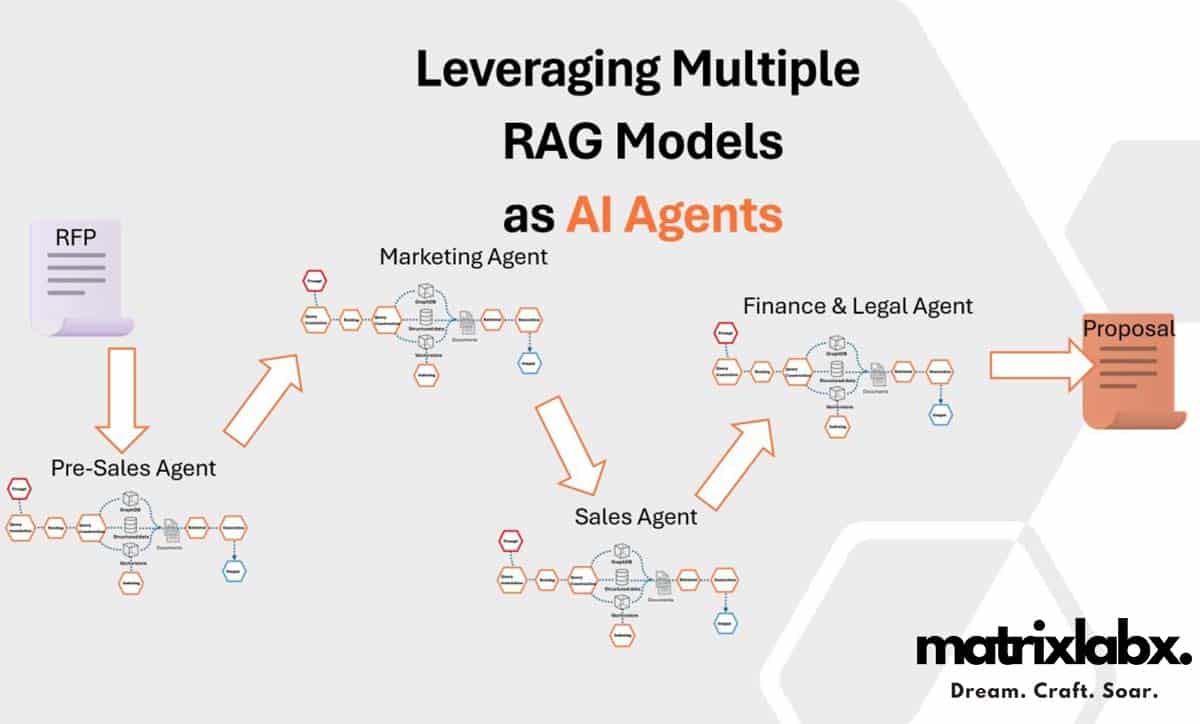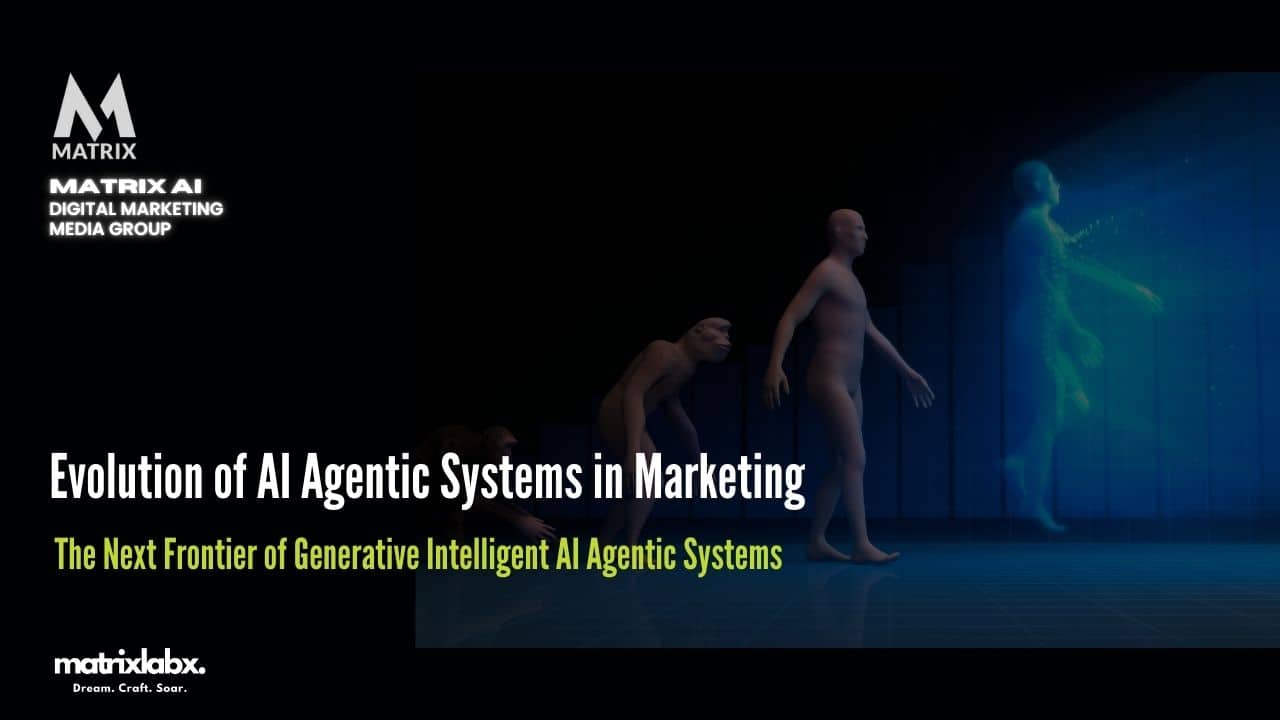History of AI Agentic Systems in Marketing: A Deep Dive
The Historical Context and Evolution of AI Agentic Systems in Marketing: A Deep Dive
Artificial intelligence has made great strides in reshaping various industries, but its evolution within marketing has been particularly transformative.
AI Agentic Systems, in particular, have brought about a paradigm shift in how marketers interact with and understand their customers, and their development has been marked by key milestones and advancements.
For Matrix Marketing Group, exploring the historical evolution of these systems illuminates their current capabilities and future potential.
Jennifer sat in her office late one evening, eyes scanning rows of campaign metrics that seemed to tell the same frustrating story. She had tried everything she could to generate more leads: webinars, email marketing, targeted ads, and even a rebranding push that should have connected with her audience. But nothing stuck, and the pressure was mounting.
“Our brand message feels scattered, and I’m not sure if our audience even understands what we offer,” she confided to a colleague one day.
Sales wanted more high-quality leads, and leadership was growing impatient, asking, “Why isn’t marketing generating a stronger impact on revenue?” Each attempt seemed to scatter her focus and erode her confidence. Jennifer worried, feeling defeated but determined to find a solution.
Just as her frustration peaked, Jennifer met Lynn from Matrix Marketing Group at an industry event. Lynn was polished, approachable, and confident, making Jennifer feel she’d finally found someone who understood the challenges of B2B marketing.
When Jennifer shared her struggles, Lynn listened intently, nodding in understanding.
“Jennifer,” Lynn said with a reassuring smile, “what if I told you that the solution isn’t necessarily more tactics but smarter, AI-driven systems that could adapt in real-time to your customers’ needs? At MatrixLabX, we’ve developed AI Agentic Systems that might be exactly what you’re looking for.”
Intrigued, Jennifer listened as Lynn explained how AI Agentic Systems could help clarify her brand’s message, enhance lead generation, and optimize campaign performance.
Lynn explained that the AI agentic systems weren’t just about crunching numbers; they could learn from data continuously, adjust marketing tactics on the fly, and provide insights that could realign her strategies with sales expectations.
Skeptical but hopeful, Jennifer decided to give it a try. Within weeks, MatrixLabX’s AI Agentic Systems were implemented into her company’s marketing operations.
The first noticeable change was how the system refined its customer segmentation, identifying clear audience personas and adjusting Jennifer’s messaging to resonate more effectively with each group. Gone were the scattered, generic messages—instead, her campaigns began to speak directly to the needs and aspirations of her target audience.
Then came the insights. The AI analyzed her past campaigns and recommended nuanced adjustments that Jennifer hadn’t considered.
For example, the system suggested specific times to reach her audience and even flagged patterns in customer engagement that pointed to untapped market segments. Jennifer quickly realized she hadn’t been using the right channels, and MatrixLabX’s predictive modeling helped her focus on those with the highest potential.
With newfound clarity, Jennifer’s campaigns began to perform better. The system’s real-time analytics allowed her to adjust messages and visuals in the middle of campaigns, ensuring they stayed relevant and compelling. She watched as lead quality improved, and the steady stream of qualified prospects silenced the persistent complaints from sales.
One evening, reviewing her latest report, Jennifer noticed a marked increase in engagement and conversion rates. For the first time, she felt she was seeing tangible ROI from her marketing efforts.
Her campaigns were no longer guesswork but calculated, data-backed strategies that resonated with her audience. She could finally report meaningful results to leadership, and the shift in her team’s morale was palpable.
As Jennifer reflected on her journey, she felt relief and pride. She no longer felt isolated in her struggle to generate leads or pressured to prove her worth to sales and leadership.
With MatrixLabX’s AI Agentic Systems, Jennifer had found a way to align her brand message, drive qualified leads, and bring focus to her team’s efforts. And as she looked ahead, she knew this was just the beginning of what she could achieve.
So how did we get here?
Empowering Intelligent Marketing with Multi-Agent RAG Systems
A New Era of AI with Matrix Marketing Group and MatrixLabX
Matrix Marketing Group, in partnership with MatrixLabX, is redefining the future of marketing through next-generation AI capabilities powered by Multi-Agent RAG Systems. This revolutionary approach elevates traditional AI, providing brands with an adaptable, deeply intelligent system for solving marketing challenges and seizing opportunities. Learn more.
Early Foundations: AI and the Beginnings of Automated Marketing
The foundation of AI Agentic Systems traces back to the early days of AI research in the 1950s and 60s. Initial AI efforts focused on building machines capable of problem-solving and learning, with early systems attempting to emulate human decision-making in a basic form.
However, it wasn’t until the 1980s and 90s, with the rise of personal computers and the advent of machine learning, that marketers began exploring how AI could optimize workflows.
Basic marketing automation systems emerged during this period, focusing on email distribution and CRM integration tasks. While these early tools were far from agentic, they marked a crucial first step toward using AI-driven solutions for marketing. These systems were rule-based, meaning they operated on static if-then rules rather than true adaptability or autonomy.
The Emergence of Machine Learning: Towards Intelligent Systems (2000s)

In the early 2000s, the evolution of machine learning brought new possibilities for marketing automation.
Machine learning enabled AI systems to learn from data without being explicitly programmed for every possible scenario, allowing for more adaptive and intelligent marketing tools.
This period saw significant data processing and analytics advancements, giving rise to predictive analytics and recommendation engines.
This shift meant that marketing systems could begin to predict consumer behavior and make suggestions based on historical patterns.
Although these systems weren’t yet fully agentic, they introduced intelligence into marketing, moving beyond static automation to predictive insights.
This era laid the groundwork for the advanced agentic systems we see today, providing marketers with deeper insights into audience preferences and behaviors.
The Rise of Big Data and Cloud Computing (2010s)
The 2010s were pivotal for AI in marketing, driven by two significant trends: big data and cloud computing. With the rapid increase in digital interactions, marketers gained access to unprecedented volumes of consumer data.
Cloud computing enables storage, processing, and analysis of massive data sets, making AI systems more complex and data-driven.
This decade witnessed the birth of agentic systems, as AI in marketing became capable of real-time analysis and decision-making.
Agentic systems are defined by their ability to make autonomous decisions and continuously learn from new data inputs, adapting without manual intervention.
For instance, by analyzing real-time customer data, these systems could adjust ad placements, update content, and refine audience segmentation on the fly.
This brought about a significant leap in marketing sophistication, as marketers could now deploy campaigns that evolved alongside changing consumer behaviors.
The Milestone of Deep Learning and Neural Networks

A key technological milestone was the advent of deep learning and neural networks, which enabled AI to reach previously unimaginable levels of sophistication.
Deep learning allowed systems to process vast amounts of unstructured data — including text, images, and video — and make sense of it in a way that mimicked human cognitive abilities.
This breakthrough was essential for marketing, where unstructured data sources like social media posts, customer reviews, and behavioral data held rich insights into consumer preferences.
Deep learning enabled AI Agentic Systems to understand these data types at scale, providing marketing teams with more granular insights and enhanced predictive accuracy.
Current AI Agentic Systems in Marketing: The MatrixLabX Approach

Today, AI Agentic Systems have become essential for many marketing departments, enabling autonomous decision-making and personalized customer interactions.
MatrixLabX is at the forefront of this evolution, with systems designed to address the complex and dynamic needs of modern B2B marketing.
MatrixLabX’s Agentic Systems stand out due to their adaptive capabilities. These make them ideal for B2B companies that require targeted, responsive campaigns that can evolve in real time.
Some of the current features of these systems include:
- Autonomous Decision-Making: MatrixLabX Agentic Systems can independently analyze and respond to new data inputs, adjusting marketing tactics.
- Continuous Learning: These systems continuously learn from every customer interaction through machine learning algorithms, refining their strategies to optimize future outcomes.
- Real-Time Personalization: MatrixLabX can deliver highly personalized content and offers by processing customer data in real time, increasing the likelihood of conversions.
IBM Granite

IBM Granite is an AI-powered data platform that enables organizations to manage and analyze large volumes of structured and unstructured data. It provides real-time insights, predictive analytics, and machine learning capabilities to help businesses make informed decisions and drive growth.
IBM’s Granite 3.0 models are designed to meet the needs of enterprise clients seeking advanced AI solutions for various business applications.
These models are particularly beneficial for organizations that enhance retrieval-augmented generation, classification, summarization, and entity extraction tasks.
By offering these models under the permissive Apache 2.0 license, IBM allows enterprises to implement and customize AI solutions tailored to their specific requirements.
Key Benefits and Importance of AI Agentic Systems Today
AI Agentic Systems have reshaped how marketers approach and measure success, with ROI as a crucial metric.
Traditional metrics, which once relied on static analytics and historical data, have now been replaced by dynamic, real-time insights.
With AI Agentic Systems, companies can better allocate resources, reduce waste, and achieve greater precision in customer targeting.
For Matrix Marketing Group, AI Agentic Systems present several benefits:
- Enhanced Efficiency: The autonomous nature of these systems reduces manual workload, allowing marketing teams to focus on strategy and creativity.
- Higher ROI: Agentic Systems improves the accuracy and impact of marketing spending by optimizing campaigns based on real-time data and predictive analytics.
- Customer-Centric Personalization: MatrixLabX’s systems enable B2B marketers to deliver relevant, personalized content, fostering stronger customer relationships and retention.
The Future of AI Agentic Systems in Marketing
The development of AI Agentic Systems still needs to be completed.
As artificial intelligence continues to evolve, we can expect these systems to become even more autonomous, contextually aware, and integrated with other AI-driven technologies. Potential advancements include:
- Cross-Platform Learning: Future agentic systems can learn across various platforms and channels, providing a unified view of customer behavior and allowing for more holistic campaign strategies.
- Enhanced Predictive Power: With further advancements in deep learning, agentic systems could more accurately predict customer needs and preferences, allowing marketers to anticipate and meet demand before it arises.
- Voice and Visual Interactions: As AI becomes more adept at processing voice and visual data, agentic systems could include new modes of customer interaction, making them more versatile in multi-channel environments.
Conclusion: The Enduring Relevance of AI Agentic Systems in B2B Marketing
The journey of AI Agentic Systems in marketing illustrates the profound ways technology has transformed the field.
From basic automation to advanced autonomous decision-making, these systems have evolved to meet the growing complexity of customer expectations and data environments.
For Matrix Marketing Group, integrating MatrixLabX’s AI Agentic Systems into its offerings represents a commitment to cutting-edge marketing solutions, empowering B2B marketers with tools to drive impactful results.
In an increasingly data-driven world, the continued relevance of AI Agentic Systems is clear. These systems are essential for achieving marketing success today and hold the key to navigating the future of customer engagement.
As we look ahead, Matrix Marketing Group and MatrixLabX are well-positioned to remain at the forefront, helping B2B marketers harness AI’s full potential in shaping customer relationships, driving ROI, and creating lasting value.


